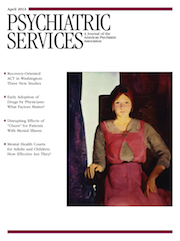The Effectiveness of Recovery-Oriented ACT in Reducing Hospital Use: Do Effects Vary Over Time?
Abstract
Objective
A previous study of recovery-oriented assertive community treatment (PACT) found large differences over three years in use of state psychiatric hospitals between PACT participants and consumers in a matched control group, especially for PACT participants with significant previous psychiatric hospitalization. This study extended these findings by examining the timing of PACT effects.
Methods
Generalized estimating equation models of monthly cost data for state, local, and crisis hospital use estimated the time-varying effects of participation in one of ten PACT teams in Washington State. Data from PACT participants (N=450) and propensity score–matched consumers (N=450) were included. Additional analyses determined whether effects differed by prior state hospital use.
Results
Differences in costs between PACT and control participants were largest immediately after PACT enrollment and tapered off. During the first quarter after enrollment, monthly per-person costs for state hospital use were $3,458 lower for PACT enrollees than for control participants. A composite measure of psychiatric hospital costs (state and local hospitals and local crisis stabilization units) declined by $3,539 monthly during the first quarter after PACT enrollment (p<.01). Differences were noted up to 27 months after enrollment, when the difference in the composite costs measure became insignificant compared with the prior quarter (months 25–27) (p>.05). Differences were larger for PACT enrollees with greater baseline state hospital use.
Conclusions
The time-varying estimates may have implications for the length and intensity of ACT enrollment. However, the optimum time for receipt of ACT services needs to be considered in the context of outcomes other than hospitalization alone.



